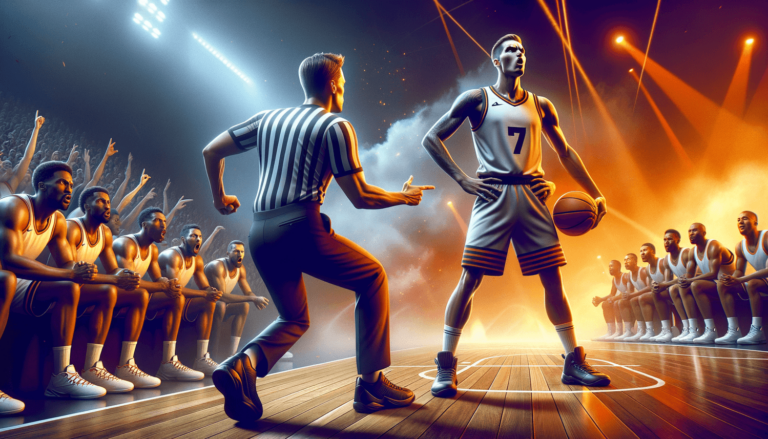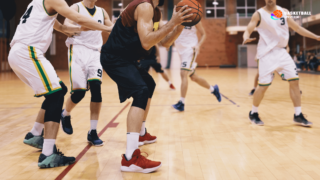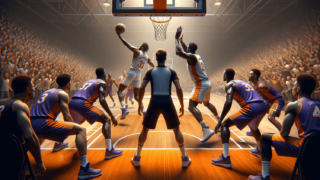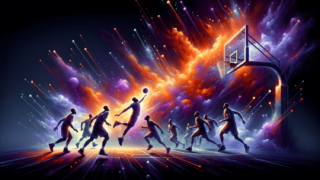
What Does Ejection Mean in Basketball?
Written by: Basketball Universe
Last updated:

Get ready to delve into the world of technical fouls, emotions running high, and referees making tough calls, as we explore the captivating topic of ejection in basketball. Regardless of whether you’re a die-hard NBA fan or a newcomer to the game, navigating the unwritten rules and intricate nuances of this beloved sport can be an adventure in itself. So buckle up, as we uncover the ins and outs of what ejection truly means in basketball, shedding light on the reasons behind it, its impact on games and players, and much more. Let the excitement begin!
What Does Ejection Mean in Basketball?
Ejection in basketball refers to the removal of a player, coach, or other team personnel from a game by the officials, typically as a result of committing multiple technical fouls, a flagrant 2 foul, or an unsportsmanlike act. Ejected individuals may not return to the game and must leave the playing area, resulting in possible disadvantages for their team, including playing with fewer players or lacking crucial guidance from their coach.
Understanding Technical Fouls and Their Role in Ejections
Before we dive deep into the world of ejections, it’s essential to understand technical fouls and their impact on this aspect of basketball. A technical foul is a type of violation that doesn’t necessarily involve physical contact between players but involves unsportsmanlike conduct or violations of the spirit and dignity of the game. Now that we’ve laid the groundwork, let’s explore the causes of ejections.
Causes of Ejections
Ejections in basketball may result from multiple causes, including committing two technical fouls, a flagrant 2 foul, or engaging in extreme unsportsmanlike behavior. Let’s take an in-depth look at each of these scenarios:
- Two Technical Fouls: When a player, coach, or other team personnel receives two technical fouls in a single game, they get automatically ejected. Technical fouls may stem from various actions such as arguing with officials, taunting opponents, using profanities, or excessively celebrating after scoring.
- Flagrant 2 Foul: The flagrant 2 foul is a more severe form of the flagrant 1 foul, involving excessive or unnecessary contact, potentially causing injury to an opponent. If a player commits a flagrant 2 foul, they’re immediately ejected from the game.
- Extreme Unsportsmanlike Behavior: In specific circumstances, a player, coach, or other personnel may face ejection for extreme unsportsmanlike conduct, even without prior technical fouls. The decision is at the discretion of the officials.
Notable Ejections in Basketball History
Some ejections have gone down in basketball history as unforgettable moments, with consequences beyond the game itself. Let’s take a trip down memory lane and explore some of the most dramatic ejections in basketball’s eventful past:
The Malice at the Palace
One of the most infamous incidents in basketball history, the “Malice at the Palace,” took place during a game between the Indiana Pacers and the Detroit Pistons on November 19, 2004. Late in the match, a brawl erupted involving multiple players from both teams, leading to the ejection of nine players in total. This chaotic event had repercussions for the NBA, with lengthy suspensions and massive fines levied against the involved players.
Rasheed Wallace’s Record
Rasheed Wallace holds the NBA record for most ejections and technical fouls in a single season, garnering a whopping 41 technical fouls and seven ejections in the 2000-2001 season. His fiery temper and on-court outbursts led to a record-setting number of penalties and made him a controversial figure in basketball during his career.
Phil Jackson’s Ejection Collection
Legendary basketball coach Phil Jackson boasts an impressive total of 29 ejections in his coaching career. Known for being a master of mind games, Jackson sometimes used his ejections to motivate his teams or disrupt the game’s momentum to shift it in his team’s favor.
Consequences of Ejections
Ejections have many consequences in the realm of basketball, not only for the expelled player or coach but for their team’s performance and morale as well. Let’s explore some of the most notable effects:
The Impact on the Game
When a player gets ejected, their team must substitute them. Losing a key player can severely impact a team’s performance or strategy, especially if the athlete is the primary scorer or their defensive leader. If the ejected player is a coach, their absence in guiding the team can equally hurt the team’s game plan and adjustments.
Penalties and Suspensions
Ejections might lead to penalties such as fines, suspensions, or both. Suspensions can have long-lasting effects on a team’s season if they lose a star player for multiple games. Teams should prioritize fostering a culture of sportsmanship and discipline to prevent severe repercussions that could derail a promising campaign.
Player Reputation
Collecting too many ejections can hurt a player’s reputation, causing them to be seen as a troublemaker or an uncoachable asset. It’s essential to learn how to keep one’s emotions in check and focus on the game, contributing positively to the team’s success.
Preventing Ejections: Tips for Players and Coaches
Ejections are never ideal, and preventing them is in the best interest of both players and coaches. Here are some helpful tips for avoiding ejections and ensuring you stay in the game:
Communicate Respectfully with Officials
Disagreeing with a referee’s decision is understandable, but arguing excessively or disrespectfully might earn you a technical foul. It’s crucial to communicate your perspective diplomatically and accept that officials’ judgments may not always rule in your favor.
Keep Your Emotions in Check
Basketball games can be heated and intense, but allowing emotions to spill over can lead to altercations, technical fouls, and ejections. Displaying sportsmanship, keeping your cool, and focusing on team goals can help keep you on the court and out of trouble.
Know the Rules and Consequences
Having a comprehensive understanding of basketball rules and the consequences of committing technical or flagrant fouls will enable players and coaches to make better decisions on the court. Familiarize yourself with the NBA or FIBA regulations applicable to your games to prevent unnecessary fouls and ejections.
Basketball Ejections: More Than Meets the Eye
Ejections in basketball serve as a vital reminder that sportsmanship and proper conduct are integral to the game’s spirit. As a result, players and coaches must maintain respect for opponents, teammates, and officials alike. Learning the intricacies of ejections and their consequences allows for a greater appreciation of the fair play that ensures basketball remains exciting, competitive, and enjoyable for all.
Managing Team Dynamics Post-Ejection
While ejections are undoubtedly disruptive to a team’s game plan, teams must be prepared to face such scenarios and manage their dynamics in the aftermath. Let’s dive into some strategies that can help basketball teams cope with the loss of an ejected player or coach:
Quickly Adjust the Lineup
After a player’s ejection, coaches must promptly make the necessary substitution and adjust the team’s lineup to compensate. Ideally, this involves leveraging the strengths of the remaining players to minimize the impact of the ejected player’s absence on team performance.
Maintain Focus and Unity
Players should remain focused on the game and stay united as a team, despite the emotional and strategic challenges they might face due to an ejection. A strong sense of teamwork and resilience can help teams overcome adversity on the court.
Rally Around the Incident
In some cases, teams can use the ejection as a source of motivation, galvanizing their camaraderie, energy, and intensity. This spirit of togetherness might provide a silver lining to an otherwise unfortunate situation.
How Fans Can React to Ejections
Fans play a pivotal role in the game of basketball, and their response to an ejection can impact the atmosphere of the game, for better or worse. Here are some tips on how fans can handle ejections during a game:
Show Support for Your Team
Continue cheering on and supporting the remaining players, as they will need that extra boost of energy and motivation to perform well in the face of adversity. Fans can be a positive force for their team, regardless of the circumstances.
Respect the Decisions of Officials
While it may be tempting to jeer at or boo the officials, it’s crucial to remember that they’re responsible for enforcing the rules and maintaining fair play. Fans should respect the officials’ decisions, even when they might disagree with them, fostering a respectful and sportsmanlike environment for everyone involved.
Keep Post-Game Discussion Balanced
Discussing the ejection and events leading up to it is natural, but remember to maintain a balanced perspective in post-game conversations. It’s crucial not to let the ejection overshadow the remaining players’ and coaches’ efforts or the quality of the game itself.
Ejections in College and High School Basketball
It’s worth noting that ejections aren’t just limited to professional basketball; they can occur in college and high school games too. Ejection rules and exact consequences might vary slightly across different collegiate conferences and state high school athletic associations. However, the core principles of sportsmanship and upholding the game’s dignity remain consistent across all levels of basketball. Players, coaches, and fans should keep these values in mind to ensure that ejections don’t detract from the joy and excitement of the game.
Frequently Asked Questions (FAQ)
Curious about ejections in basketball? We’ve compiled a list of frequently asked questions and their answers to provide you with additional insight into this essential aspect of the game. Take a look below to learn more!
1. Is a player ejected for receiving two personal fouls?
No, a player is not ejected for committing two personal fouls. However, they may be disqualified from the game if they accumulate six personal fouls (in the NBA) or five personal fouls (in college basketball). Ejections typically result from multiple technical fouls or a flagrant 2 foul.
2. How many technical fouls does it take for a player to be ejected from the game?
A player is ejected from the game upon receiving two technical fouls. These fouls could result from unsportsmanlike conduct or violations that do not entail physical contact between players.
3. Do ejections lead to automatic suspensions?
Ejections do not automatically lead to suspensions. However, the NBA or other basketball organizing bodies may review the incident and decide to issue additional penalties, such as fines or suspensions, depending on the severity and circumstances of the ejection.
4. Can a coach be ejected from a basketball game?
Yes, coaches can be ejected from basketball games for reasons similar to players, such as receiving two technical fouls or engaging in extreme unsportsmanlike conduct.
5. What happens if multiple players are ejected from a game and a team doesn’t have enough players to continue?
In rare cases where a team has less than five players available due to ejections, injuries, or other factors, the game can continue with fewer players on the court. However, this is a significant disadvantage and can have a substantial impact on the team’s performance.
6. Is a player’s ejection announced to the audience?
Yes, an official announcement is made over the arena’s public address system to inform everyone in attendance about the ejection and the reasons behind it.
7. How does an ejected player’s team handle the loss of personnel?
The team must make a substitution to replace the ejected player. Additionally, the coach and players on the court must adjust their strategy and roles to compensate for the loss of the ejected player.
8. What are some examples of conduct that could lead to a flagrant 2 foul and ejection?
A flagrant 2 foul involves unnecessary and excessive contact, often with the potential to cause injury. Examples include striking, kicking, or elbowing an opponent with severe force, or committing a dangerous and reckless play.
9. Are ejections more common in professional or amateur basketball?
Ejections can occur at all levels of basketball, from professional to amateur. However, the frequency of ejections may vary depending on the level of competition, officiating standards, and the players and coaches’ maturity and experience.
10. Do referees face any consequences for ejecting a player unnecessarily or in error?
If an official’s decision to eject a player is deemed incorrect or unnecessarily harsh, the league or governing body may review the decision, potentially impacting the official’s future assignments and reputation. Referees, like players and coaches, are expected to uphold high standards of professionalism and integrity in their decisions.
11. Can an ejection be reversed?
Once a player or coach has been ejected from the game, the decision is typically irreversible. However, in rare cases, if the officials determine that they made an error, they may reinstate the individual. Such instances are highly uncommon.
12. Can a player be ejected for their conduct off the court?
Situations regarding off-court behavior are usually handled separately from in-game ejections. However, serious incidents of misconduct off the court can lead to suspensions, fines, or other consequences imposed by the league or organizing body.
13. How can I learn more about basketball rules and ejections?
To learn more about basketball rules and ejections, we recommend reviewing official rulebooks and guidelines provided by the NBA, NCAA, FIBA, or your relevant local basketball governing body. Additionally, watching games, reading articles, or engaging with experienced players and coaches can deepen your understanding of the topic.
Featured Posts
- No pillar pages found.





